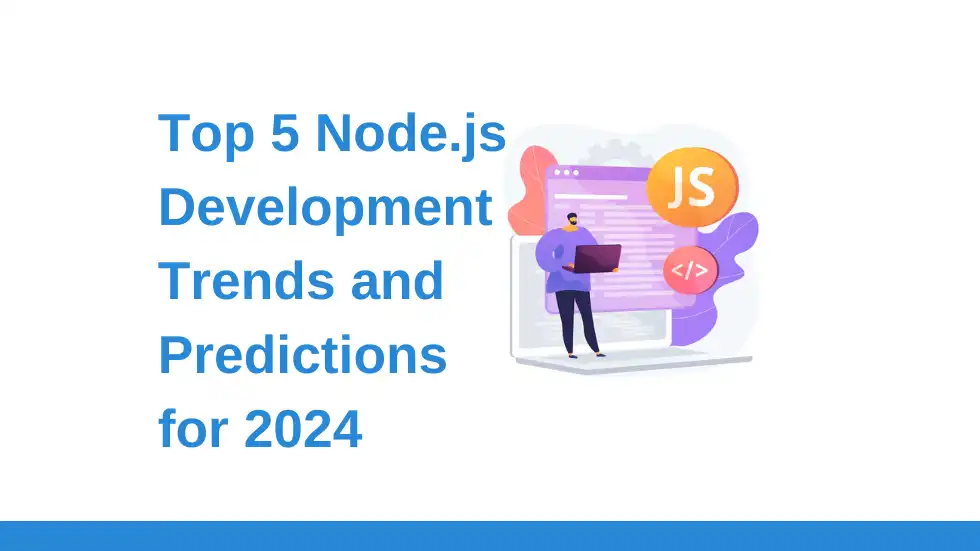Node.js continues to dominate the landscape of server-side application development in 2024.
Its event-driven, non-blocking I/O model, JavaScript foundation, and vast ecosystem make it an attractive choice for a wide range of web development projects. However, the web development landscape is constantly evolving, and Node.js is no exception.
This blog post explores five key Node.js development trends and predictions for 2024, equipping developers and businesses with valuable insights for the coming year.

1. Real-Time Applications with WebSockets in node.js development
Challenge: Traditional HTTP requests can lead to delays and a diminished user experience in real-time applications like chat, collaboration tools, and multiplayer games.
Solution: WebSockets establish a persistent two-way communication channel between client and server, enabling real-time data exchange and instant updates.
2024 Prediction: We expect a surge in WebSocket adoption within Node.js development for building highly interactive and engaging real-time experiences. Libraries like Socket.IO and ws will continue to play a vital role in simplifying WebSocket integration.

2. Serverless Architectures with Node.js
Challenge: Managing and scaling traditional server infrastructure can be complex and resource-intensive, especially for applications experiencing fluctuating traffic patterns.
Solution: Serverless architectures offload server management and scaling responsibilities to the cloud provider. Developers can focus on their core application logic, and the cloud platform handles provisioning and scaling resources based on demand.
2024 Prediction: We anticipate a continued rise in serverless computing powered by Node.js on platforms like AWS Lambda and Azure Functions. This trend will be further driven by improved cold start times and expanded functionalities offered by cloud providers.

3. Microservices with Node.js
Challenge: Monolithic applications can become cumbersome to maintain and scale as features and functionalities grow.
Solution: Microservices architectures break down applications into smaller, independent, and deployable services, each responsible for a specific business domain. This promotes modularity, scalability, and faster development cycles.
2024 Prediction: Node.js, with its lightweight nature and modular design, will remain a popular choice for building microservices. Frameworks like NestJS and Fastify will continue to gain traction, providing robust tooling and features for efficient Node.js development of microservices.

4. Machine Learning Integration with Node.js
Challenge: Traditionally, integrating machine learning (ML) capabilities into web applications often required a separate backend server written in another language.
Solution: Frameworks like TensorFlow.js and Brain.js enable developers to run ML models directly within the browser, utilizing Node.js as the server-side component for pre-processing data, serving models, and managing predictions.
2024 Prediction: We expect increased experimentation and adoption of Node.js for server-side integration and management of ML models, especially for tasks like personalized recommendations, sentiment analysis, and image recognition within web applications. This will be a significant advancement in Node.js development trends.

5. GraphQL for Efficient API Development
Challenge: Traditional REST APIs can become cumbersome to manage and inefficient when fetching complex data structures, requiring multiple API calls to retrieve related data.
Solution: GraphQL is a query language for APIs that allows clients to request specific data they need in a single request, reducing roundtrips and improving performance.
2024 Prediction: We predict growing adoption of GraphQL in Node.js development, especially for building complex APIs serving data-intensive web applications. Libraries like Apollo Server and GraphQL Yoga will continue to simplify GraphQL integration and server implementation.
Beyond the Trends: Continuous Learning and Innovation
While these trends offer valuable insights into the future of Node.js development, it’s crucial to remember that the technology landscape is constantly evolving. Here are some key takeaways for developers and businesses to stay ahead of the curve in Node.js development trends:
- Stay Updated: Regularly explore new libraries, frameworks, and tools emerging in the Node.js ecosystem.
- Embrace Experimentation: Don’t be afraid to experiment with innovative technologies and paradigms, like serverless functions and ML integration.
- Prioritize Security and Maintainability: Focus on security best practices and code quality to ensure long-term application stability and resilience.
Conclusion
Node.js remains a powerful and versatile platform for building modern web applications.
By staying informed about these evolving Node.js development trends, embracing continuous learning, and fostering a culture of innovation, developers and businesses can leverage the full potential of Node.js in 2024 and beyond.
The key to success lies in understanding your application’s specific needs and selecting the technologies and practices that best suit your requirements.
Additional Resources:
